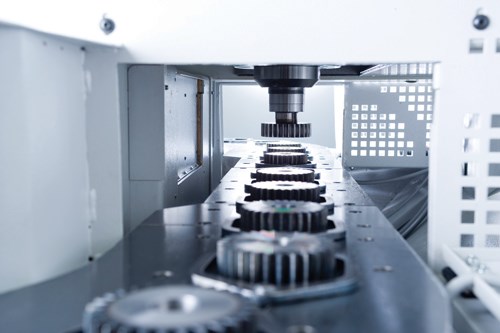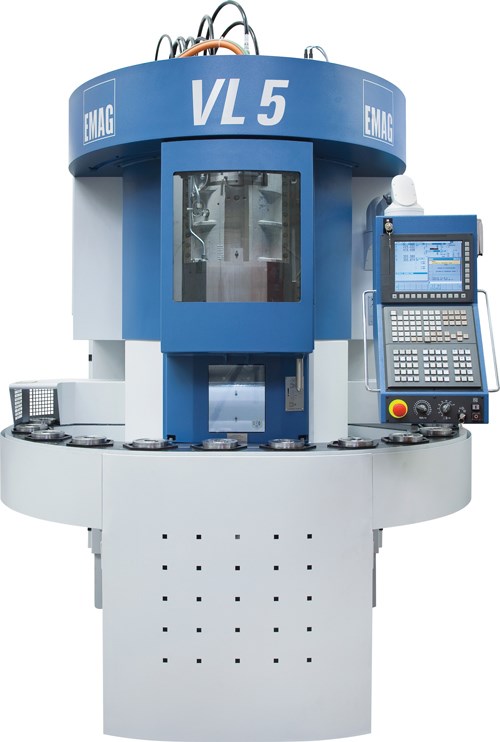Hard Turning with Inverted Vertical Turning Centers
When it comes to the machining of hardened surfaces, hard turning is a particularly efficient solution that, compared with grinding, offers a radical reduction of machining times and investment costs.
Our cars are full of high-tech materials that ensure a long life for the individual components and make the car safe to drive. These materials also weigh much less than in the past, which reduces fuel consumption levels.
To ensure they are machined in a cost-effective way requires the right process and machinery. The inverted vertical turning center, such as Emag LLC’s VL 5, is a machine that is customized for hard turning.
The company pioneered the inverted vertical concept in the 1980s and continues to refine the self-load and unload capabilities inherent in the design. It’s a design that creates advantages to the machine’s highly demanding field of application, which includes continuous part processing at high volume/low mix and high mix/low volume production.
The conditions faced by sub-suppliers and manufacturing companies have been the same for decades: optimal component quality, flexible batch sizes and low workpiece costs. These are the demands made by customers in industries and applications.
However, these demands are difficult to fulfill when machining already hardened surfaces. Grinding is the method used most often for achieving the results necessary for hardened surfaces, but it is time consuming and known for its relatively high tooling costs and energy consumption.
Hard turning is an alternative process that is being used more often, both in the small batch and the mass production of hardened workpieces. The hard turning process offers equivalent surface finishes and allows for the process chain to be shortened by eliminating the grinding process.
Also, turning machines are less expensive than grinders, and their energy consumption is lower. Unlike the grinding process, hard turning can often be carried out dry, which is more environmentally friendly.
Inverted Design for Hard Turning
The VL 5 is specifically designed for hard turning heat-treated workpieces. Its features make it capable of handling the heavy stresses during hard turning. The machine’s base is constructed of Mineralit, a polymer concrete with a vibration resistance 8× better than cast iron. Stability is critical for hard turning because any chatter generated in the turning process transfers to the workpiece.
“A vibration-resistant machine leads to an improved surface finish on all workpieces it machines, which also leads to an improvement in tool life,” says Peter Loetzner, CEO, Emag.
The machine’s work spindle and workpiece are located above the tool, which offers ideal chip flow conditions as the material is removed from the machine by a chip conveyor.
All of the machine’s guideways are located above and away from the machining zone, keeping them clear from chips or dirt. This increases the component accuracy and reduces the maintenance effort, the company says.
The machine has the ability to include integral automation and uses a conveyor belt with prisms that hold the raw parts in place. The conveyor belt moves the workpieces directly into the pick-up station, where they are picked up by the work spindle and then machined. Workpiece change-overs are fast—the distance traveled between the loading and machining position is only 550 mm. This shortens the time between machining processes.
In the Real World
One shop uses the VL 5 to produce gears for an automotive industry sub-supplier. The machine produces a total of eight different gears for a dual-clutch transmission system.
Following the hardening process, the workpieces are pre-turned on the machine to remove the hardened top layer, then a synchronous ring is welded onto the workpiece away from the vertical turning center. The workpiece is then returned to the machine and finish-turned.
Before this shop had the vertical lathes, comparable operations were performed on grinders. “This company started investing in machines for their hard turning process as an alternative to grinding, because the investment costs were so much lower,” Mr. Loetzner says. Also, the machine leaves the workpieces with an amazing surface finish, according to the company. “Hard turning on the VL 5 is in no way inferior to the old grinding process, and the machining times are noticeably shorter,” he says.
From Bearing Ring to Gear
When can hard turning successfully replace the grinding process in the machining of a component surface? “That depends on a number of factors. One important factor is the desired surface texture,” Mr. Loetzner says. “We help guide our customers and give them our opinion on the best way to proceed, and when hard turning is possible, it often becomes first choice.”
Apart from lower investment costs, many users are also impressed by the elimination of grinding operations. On the vertical lathe, the turned part can be finish-machined in a single setup. It is no longer necessary to take it to another machine for finishing. The result: The output level of the whole production increases considerably.
The inverted vertical concept is catching on in manufacturing shops. According to the company, Emag has delivered a total of 3,500 of these machines.
The experience garnered from these installations is applicable to shops looking at implementing this technology for their business. “Our design team familiarizes themselves with customer demands. This ensures that the design and application of these machines are targeted on what is required by customers,” Mr. Loetzner says.
The type and number of components that can be produced on these vertical turning machines are diverse. Toothed components, such as gears and crown wheels, can be produced with the same efficiency as bearing rings.
“The system can be adapted to suit any batch size and is impressive with its short cycle times and high component quality. If the VL 5 allows a two-step, turn/grind process to be reduced to a single handling with the part hard-turned complete, this is a significant production and cost savings advantage,” Mr. Loetzner says.
Related Content
High-Volume Machine Shop Automates Secondary Ops
An Ohio contract shop added a compact, self-loading CNC lathe to perform unattended secondary ops on a part for a key customer rather than running it on a manually loaded chucker.
Read MoreRacer Machinery Lathe Enables Full Ram Travel
The VTX machine series features programmatic indexing of the Y-axis, enabling for extended height to accommodate taller parts.
Read MorePMTS 2023 Product Preview: High-Volume Turning
Learn about some of the latest high-volume turning solutions that will be on display at PMTS 2023.
Read MoreMazak Horizontal Turning Center Enables Versatile Machining
The QT-Ez 8MSY horizontal turning machine integrates seamlessly with bar feeders and robots, and accepts many additional options to tailor it to the needs of any shop.
Read MoreRead Next
The Upside of Vertical Turning
Vertical turning centers that use the main spindle to load and unload themselves are finding increasing acceptance as multitasking capabilities make them efficient processing centers for producing chucked parts.
Read MoreDo You Have Single Points of Failure?
Plans need to be in place before a catastrophic event occurs.
Read MoreA Tooling Workshop Worth a Visit
Marubeni Citizen-Cincom’s tooling and accessory workshop offers a chance to learn more about ancillary devices that can boost machining efficiency and capability.
Read More











.jpg;maxWidth=300;quality=90)




.jpg;maxWidth=300;quality=90)







